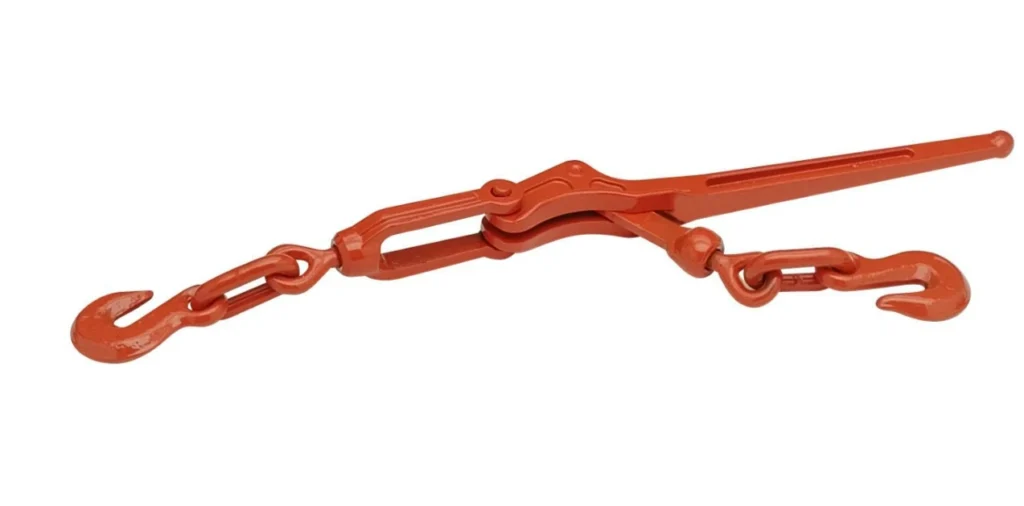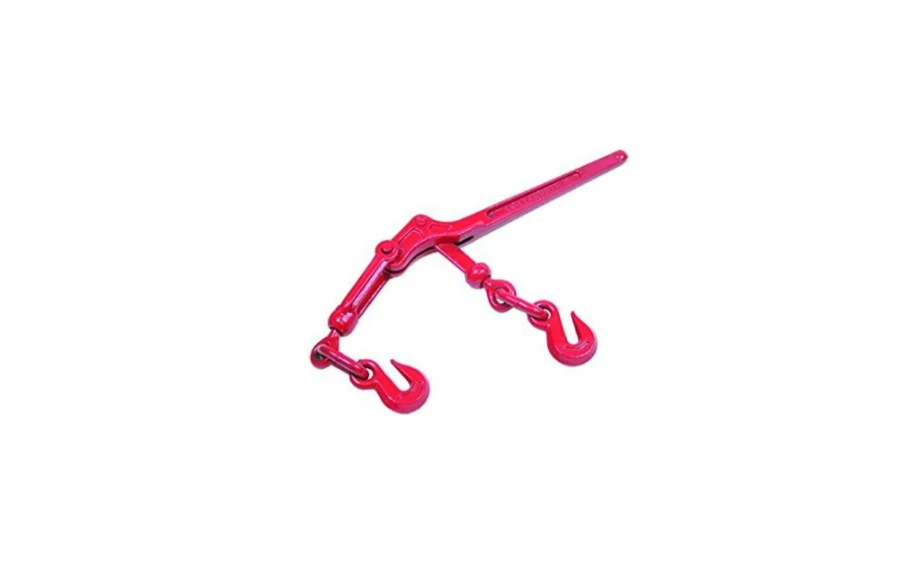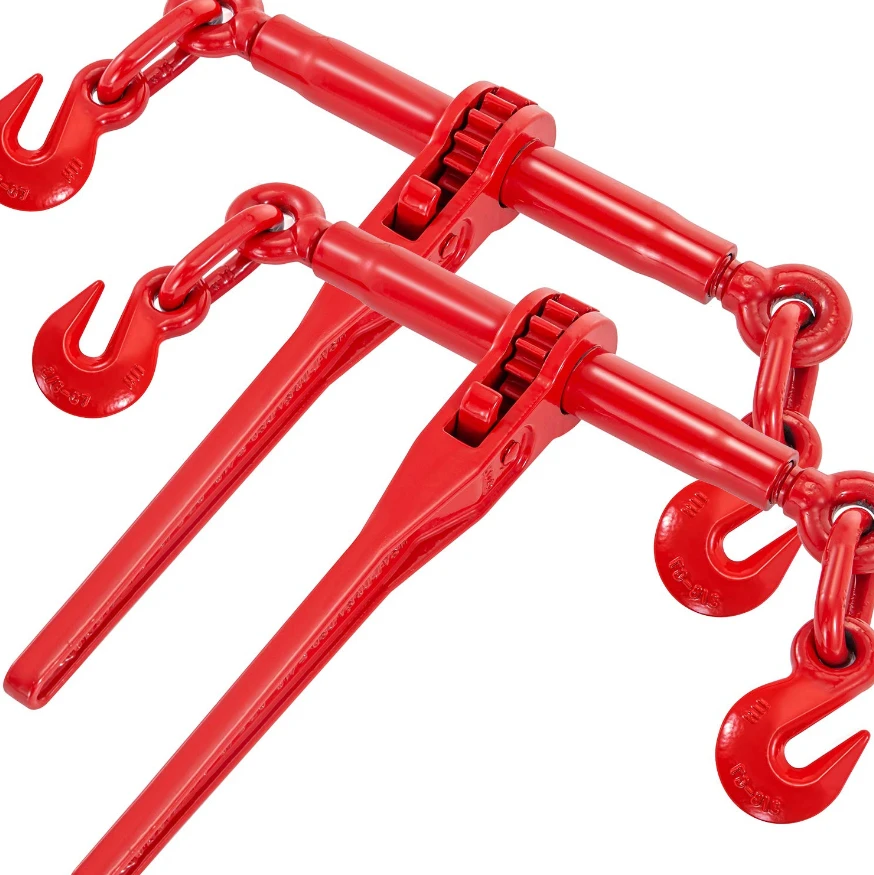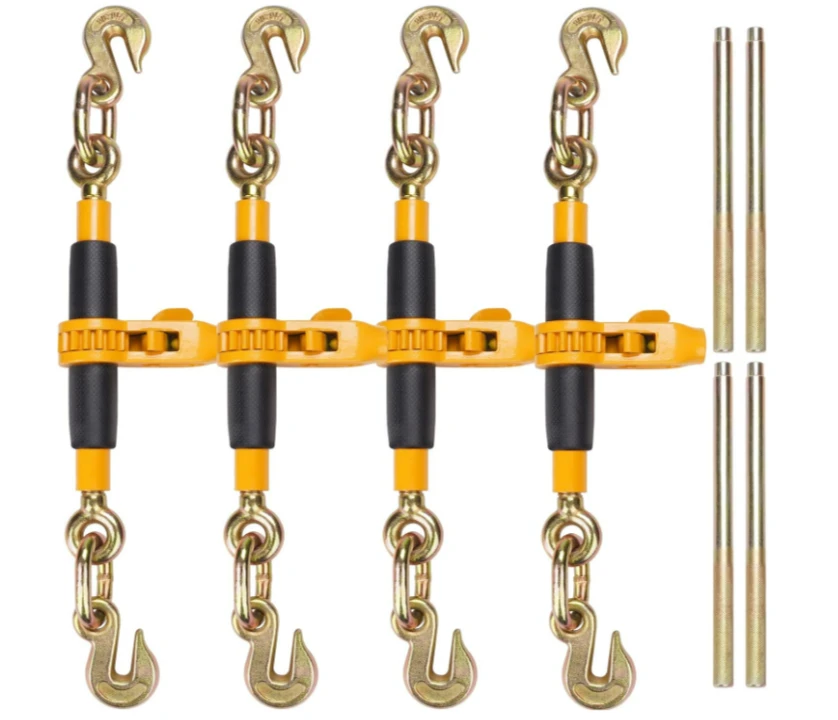Chain binders are devices that are used to tighten and secure chains around cargo on flatbed trailers. They are also known as load binders, chain tensioners, or chain binders. Chain binders come in two main types: ratchet-style and lever-style. Each type has its own advantages and disadvantages, depending on the size, weight, and shape of the cargo, as well as the personal preference of the user.
In this article, we will explain how to use chain binders properly, what are the benefits and drawbacks of each type, and what are some of the best chain binders you can buy on Amazon. We will also answer some of the most frequently asked questions about chain binders.
How to Use Chain Binders
Before using chain binders, you need to have the right size and grade of transport chain for your cargo. Transport chains are classified by grades, which indicate their strength and durability. The most common grades for flatbed trucking are Grade 70, Grade 80, and Grade 100. Grade 70 chains are made of carbon steel and have a gold finish. Grade 80 and Grade 100 chains are made of alloy steel and have a black finish. Grade 80 and Grade 100 chains are stronger and more resistant to wear and tear than Grade 70 chains, but they are also more expensive.
The size of the chain is measured by the diameter of the links. The most common sizes for flatbed trucking are 1/4 inch, 5/16 inch, 3/8 inch, and 1/2 inch. The larger the chain, the higher the working load limit (WLL) and the breaking strength. The WLL is the maximum weight that the chain can safely handle, while the breaking strength is the maximum weight that the chain can withstand before breaking. The WLL and the breaking strength of the chain depend on the grade, the size, and the manufacturer of the chain.
To use chain binders, you need to follow these steps:
- Place the chain over the cargo and hook it to the trailer on both ends. Make sure the chain is not twisted or tangled, and that it is tight enough to prevent the cargo from shifting.
- Choose the right type and size of chain binder for your chain. The chain binder should match the grade and the size of the chain, and have a WLL that is equal to or greater than the WLL of the chain. For example, if you are using a 3/8 inch Grade 70 chain, you should use a 3/8 inch chain binder with a WLL of at least 6,600 lbs.
- Attach the chain binder to the chain on both ends. Make sure the hooks of the chain binder are securely engaged with the links of the chain, and that the chain binder is aligned with the direction of the chain.
- Tighten the chain binder by using the handle. Depending on the type of chain binder, you may need to pull, push, or rotate the handle to apply tension to the chain. Be careful not to over-tighten the chain binder, as this may damage the chain or the cargo. The chain should be snug, but not too tight.
- Secure the handle of the chain binder by using a safety pin, a snap, or a lock. This will prevent the handle from loosening or releasing accidentally. Do not use bungee cords, wire, or tape to secure the handle, as these are not reliable or safe.
- Repeat the process for each chain and chain binder that you need to use. You should use enough chains and chain binders to evenly distribute the weight of the cargo and to comply with the federal and state regulations. The number and placement of chains and chain binders depend on the size, weight, and shape of the cargo, as well as the length and width of the trailer.
Ratchet-Style vs Lever-Style Chain Binders
Ratchet-style and lever-style chain binders are the two main types of chain binders that are used for flatbed trucking. They differ in the way they tighten and release the chain, as well as in their features and performance.
Ratchet-Style Chain Binders
Ratchet-style chain binders use a ratcheting mechanism to tighten and release the chain. They have a handle that rotates in one direction to apply tension to the chain, and in the opposite direction to release the tension. Ratchet-style chain binders have the following advantages and disadvantages:
- Advantages:
- They are easy to use and adjust, as they allow for precise and gradual tightening and loosening of the chain.
- They are safer and more stable, as they do not store energy or recoil when released.
- They are more versatile, as they can accommodate different sizes and grades of chains by using different hooks or adapters.
- Disadvantages:
- They are heavier and bulkier, as they have more moving parts and a larger handle.
- They are more expensive, as they have a more complex and durable design.
- They are more prone to rust and corrosion, as they have more metal surfaces and crevices.
Lever-Style Chain Binders
Lever-style chain binders use a lever mechanism to tighten and release the chain. They have a handle that pivots in one direction to apply tension to the chain, and in the opposite direction to release the tension. Lever-style chain binders have the following advantages and disadvantages:
- Advantages:
- They are lighter and more compact, as they have fewer moving parts and a smaller handle.
- They are cheaper, as they have a simpler and less robust design.
- They are less likely to rust and corrode, as they have fewer metal surfaces and crevices.
- Disadvantages:
- They are harder to use and adjust, as they require more force and skill to tighten and loosen the chain.
- They are less safe and more unstable, as they store energy and recoil when released.
- They are less versatile, as they can only accommodate specific sizes and grades of chains.
Best Chain Binders on Amazon
If you are looking for chain binders to buy on Amazon, here are some of the best options that we recommend:
- Ultra-Tow 3/8in. Ratchet Chain Binder — 9200-Lb. Load Capacity: This is a ratchet-style chain binder that can handle chains of 3/8 inch or 1/2 inch in size, and has a WLL of 9,200 lbs. It has a forged steel construction, a powder-coated finish, and a spring-loaded pawl. It is easy to use, safe, and durable. You can buy it here.
- Durabilt Ratchet Load and Lock Chain Binder — 7100-Lb. Load Capacity: This is another ratchet-style chain binder that can handle chains of 5/16 inch or 3/8 inch in size, and has a WLL of 7,100 lbs. It has a forged steel construction, a zinc-plated finish, and a detachable handle. It is versatile, reliable, and convenient. You can buy it here.
- Peerless QuikBinder Plus Ratchet Chain Binders — 12,000-Lb. Load Capacity: This is a premium ratchet-style chain binder that can handle chains of 3/8 inch or 1/2 inch in size, and has a WLL of 12,000 lbs. It has an alloy steel construction, a powder-coated finish, and a folding handle. It has three modes of operation: ratchet extension, ratchet take-up, and free spin. It is adjustable, flexible, and secure. You can buy it here.
- Ultra-Tow 5/16in. Lever Chain Binder — 5400-Lb. Load Capacity: This is a lever-style chain binder that can handle chains of 5/16 inch or 3/8 inch in size, and has a WLL of 5,400 lbs. It has a forged steel construction, a powder-coated finish, and a ball and socket swivel. It is lightweight, compact, and easy to store. You can buy it here.
- American Power Pull 13050 Load Binder: This is another lever-style chain binder that can handle chains of 1/4 inch or 5/16 inch in size, and has a WLL of 2,600 lbs. It has a drop-forged steel construction, a heat-treated finish, and a ball and socket swivel. It is economical, simple, and effective. You can buy it here.

FAQ
How many chain binders do I need for my cargo?
The number of chain binders you need depends on the size, weight, and shape of your cargo, as well as the length and width of your trailer. You should use enough chain binders to evenly distribute the weight of the cargo and to comply with the federal and state regulations. As a general rule, you should use at least one chain binder for every 10 feet of cargo length, and at least four chain binders for the entire cargo.
How do I know if I have tightened the chain binder enough?
You can use a tension indicator or a tension meter to measure the tension of the chain. A tension indicator is a device that attaches to the chain and shows the tension level by using a color-coded scale. A tension meter is a device that hooks to the chain and displays the tension value in pounds or kilograms. You should tighten the chain binder until the tension reaches the recommended level for your chain size and grade. You can find the recommended tension levels in the manufacturer’s manual or on the chain binder’s label.
You can also use a visual inspection to check the tension of the chain. You should tighten the chain binder until the chain is snug, but not too tight. The chain should not sag, slack, or bend excessively. The chain should also not cut into the cargo or the trailer. You should be able to fit one or two fingers between the chain and the cargo, but not more. If the chain is too loose, it may allow the cargo to shift or fall off. If the chain is too tight, it may damage the chain or the cargo.




